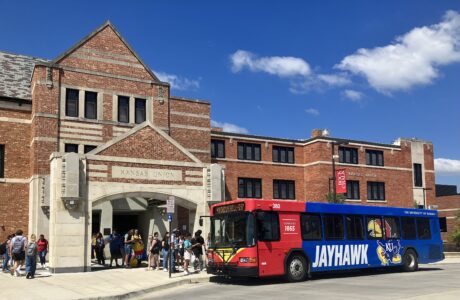As KU discusses pay increases, it remains unclear whether a union representing faculty members will form

photo by: Kim Callahan/Journal-World
The Kansas Union on the University of Kansas campus is pictured on Tuesday, Aug. 23, 2022.
As University of Kansas leaders undertake a major study to determine possible pay increases, it is uncertain whether a new union representing KU faculty will emerge and be part of the process.
In November, a group affiliated with the American Federation of Teachers and the American Association of University Professors announced it was taking the necessary steps to form a union to represent the approximately 1,500 members of the KU faculty and academic staff.
But both a labor organizer and university leaders have recently confirmed the union has not yet formed, although an organizer said it is still working to gather union authorization cards from members of the KU faculty.
Lisa-Marie Wright — a faculty member in KU’s sociology department and a member of the budding union’s communications committee — told the Journal-World that fall is likely the earliest the group would actually seek to form a union at the university. She said the effort was still in the outreach phase with faculty and staff members.
“Our faculty and staff are still very enthusiastic,” she said. “We have some fun summer events planned.”
Wright did not provide any details on how many faculty or staff members have signed union authorization cards. State law requires 30% of a group of employees to sign authorization cards in order to trigger an election. In the secret ballot election, if a majority of employees vote to form a union, then KU would be required to recognize the union and negotiate with it on matters related to pay, benefits, working conditions and other similar topics.
KU leaders recently said they haven’t received any updates from the organizers on how efforts to form a union are progressing or when an election date might be set.
Talk of a union comes as KU is undertaking a major study this summer to determine what positions at the university are currently underpaid compared to the private sector. As the Journal-World reported last week, KU hopes to begin making some “market-based” pay adjustments to selected positions in January.
KU also is proposing to give a 2.5% cost-of-living increase to essentially all university employees.
KU is able to provide raises and make other changes to employee compensation and benefits without collectively bargaining with employees, in most cases. Graduate Teaching Assistants at KU are represented by a union. That group — which has about 100 dues paying members, according to information previously provided by KU — agreed to a 5% pay increase in September. That pay increase was consistent with what other KU employees received last year.
The two sides had negotiated about 30 times over a 16-month period before reaching the one-year agreement.
While graduate teaching assistants are unionized, KU’s overall faculty has long been a non-unionized group. That’s not the case everywhere. In Kansas, Pittsburg State and Fort Hays State both recently had union contracts for faculty members updated and approved.
The Kansas Board of Regents last week approved a $200 pay increase for all Pitt State faculty members who achieved an “exceptional” rating on their employee evaluation. In addition to the $200 increase, the new contract calls for a 2.25% wage adjustment for all members, plus the university agreed to create a pool of $45,000 to fund wage adjustments for faculty members who are receiving promotions.
Regents approved a contract at Fort Hays State that will provide a 2.5% wage increase for all 354 faculty members, plus will create an approximately $185,000 pool to provide wage increases for members who received promotions or newly earned advanced degrees. The contract also tentatively commits Fort Hays State to provide nearly $53,000 in wage adjustments to bring certain university salaries more in line with competitors, although that provision is contingent upon upcoming enrollment numbers.







